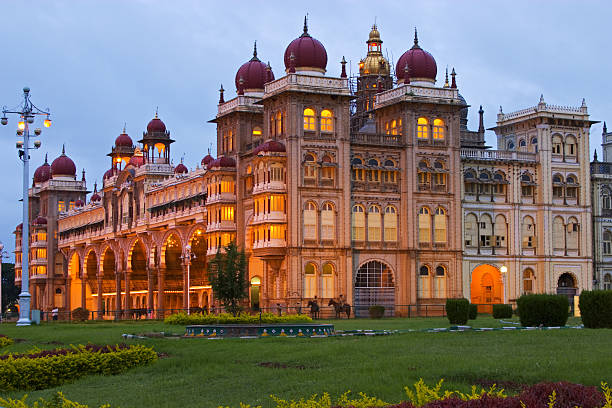Mysore palace
 The foundation of the Mysore Palace dates back to the 14th century, established by the Wodeyars, the ruling family of Mysore. Legend has it that Yaduraya Wodeyar, the Mysore Palace king, constructed a palace in Puragiri, known as the Old Fort, during his reign. This original palace, considered the precursor to the present structure, underwent multiple demolitions and reconstructions over six centuries.
Originally a wooden fortress, the palace faced destruction when struck by lightning in 1638. Under Kantirava Narasa Raja Wodeyar’s rule, it was reconstructed. When Tipu Sultan assumed control of the Wodeyar Dynasty in 1793, he razed the palace and erected a new one. However, in 1799, after Tipu Sultan’s demise, Krishnaraja Wodeyar III took charge and remodeled the palace in the Hindu architectural style
Tragedy struck in 1897 during Princess Jayalakshmmanni’s wedding ceremony when fire ravaged the palace. Maharani Kempananjammanni Devi and Maharaja Krishnaraja Wodeyar IV resolved to rebuild. British architect Henry Irwin was commissioned for the task, completing the palace in 1912 at a staggering cost exceeding 41 lakh Indian rupees. Subsequent expansions, including the addition of the Public Durbar Hall wing during Jayachamarajendra Wadiyar’s reign in the 1930s, further enhanced the palace’s grandeur.
Mysore Palace, an architectural gem in Karnataka, blends Indo-Saracenic and traditional Mysorean styles. Its opulent exteriors boast domes, arches, and vibrant facades adorned with intricate carvings and colorful frescoes. Inside, visitors are treated to luxurious interiors featuring marble floors, gilded columns, and ornate ceilings. The palace’s grandeur is epitomized by the Public Durbar Hall, a majestic venue for royal ceremonies and cultural events. With its rich heritage and timeless elegance, Mysore Palace captivates all who visit, offering a glimpse into Karnataka’s regal past.
The foundation of the Mysore Palace dates back to the 14th century, established by the Wodeyars, the ruling family of Mysore. Legend has it that Yaduraya Wodeyar, the Mysore Palace king, constructed a palace in Puragiri, known as the Old Fort, during his reign. This original palace, considered the precursor to the present structure, underwent multiple demolitions and reconstructions over six centuries.
Originally a wooden fortress, the palace faced destruction when struck by lightning in 1638. Under Kantirava Narasa Raja Wodeyar’s rule, it was reconstructed. When Tipu Sultan assumed control of the Wodeyar Dynasty in 1793, he razed the palace and erected a new one. However, in 1799, after Tipu Sultan’s demise, Krishnaraja Wodeyar III took charge and remodeled the palace in the Hindu architectural style
Tragedy struck in 1897 during Princess Jayalakshmmanni’s wedding ceremony when fire ravaged the palace. Maharani Kempananjammanni Devi and Maharaja Krishnaraja Wodeyar IV resolved to rebuild. British architect Henry Irwin was commissioned for the task, completing the palace in 1912 at a staggering cost exceeding 41 lakh Indian rupees. Subsequent expansions, including the addition of the Public Durbar Hall wing during Jayachamarajendra Wadiyar’s reign in the 1930s, further enhanced the palace’s grandeur.
Mysore Palace, an architectural gem in Karnataka, blends Indo-Saracenic and traditional Mysorean styles. Its opulent exteriors boast domes, arches, and vibrant facades adorned with intricate carvings and colorful frescoes. Inside, visitors are treated to luxurious interiors featuring marble floors, gilded columns, and ornate ceilings. The palace’s grandeur is epitomized by the Public Durbar Hall, a majestic venue for royal ceremonies and cultural events. With its rich heritage and timeless elegance, Mysore Palace captivates all who visit, offering a glimpse into Karnataka’s regal past. 